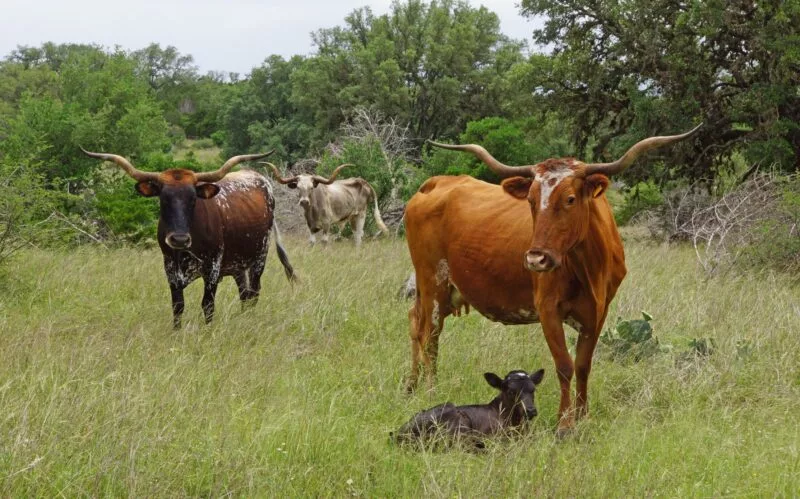
What are the best homesteading cattle? No question. It’s the pure, historic Texas Longhorn. Not the fake, cross-bred front pasture version of this animal. But the real thing.
I can hear people screaming in laughter but read on and we’ll see. I have raised pure Longhorn cattle in Central Texas for 17 years.
There are two animals we could be talking about, so let’s get that settled first… 1. Cattle with long horns, or, 2. Pure, genetically correct, DNA-tested historic Texas Longhorn Cattle. The two things are not synonymous. Unhappily, most Longhorns are “wronghorns.” They are not pure Texas Longhorns. Most are crossbred with African and European cattle by breeders who breed only for meat and horn size. And the difference is important.
True and pure Texas Longhorn cattle are profoundly different from the commercial cows (actually European breeds) that are available today. It isn’t just a few minor trait differences we are looking at; the pure Longhorn is a whole different animal.
The true, historic Longhorn is a smallish example of cattle. The female rarely tops 800 lbs. The steer or bull may get upwards of 1800 lbs., but it will take him 5-6 years to get that big.
The Longhorn thrives on stuff other cows will not even eat. They will eat weeds, thistles, scrub brush, etc. as well as grass when it is available. The result of these first two traits is that you can keep 3 Longhorns in the same area where you could only keep one commercial cow. The commercial cow is designed (by humans) to live a fairly short life. Finding a 10-year-old commercial/European breed cow is very rare. The commercial cow will likely only produce 5 or 6 offspring in their short life. The rare, pure Longhorn, however, can live a very long life, and it is not unheard of to have a cow still producing a calf (every 10-11 months) well into its 20’s and 30’s. We had a Longhorn cow die this past year who we bought in 2006 and she was already pretty old when we got her. We figure she was four or five years old when we picked her up from Brownwood’s own Frank Sharp in 2006.
The Longhorn “breeds back” (becomes pregnant again after calving) faster than any other cow. Although it is only a slight exaggeration, the old ranchers used to say that “the Longhorn will calf every 9 months and 15 minutes.”
Remember, we’re not talking about commercial longhorns here. We’re talking about pure, Spanish, genetically correct, and DNA-tested pure Texas Longhorns, such as those protected and raised by cattle raisers associated with the Cattleman’s Texas Longhorn Registry (CTLR.)
The Longhorn survived and thrived in the deserts of Texas and Mexico without any aid from, or crossbreeding by, man. The commercial breeds – even what most people believe are Longhorns – are mutts, concoctions of man bred for purely short-term economic reasons. They’re fine for what they are, but when the 7-year drought hits (like it did here not long ago,) those other breeds have to be fed and watered by very costly systems, or they have to be sold off or butchered.
After hundreds of years living wild in Texas and Mexico, they were called “mustangs” by the cowboys and there were literally millions of pure Longhorn cattle free for the taking. These beasts had developed naturally into creatures designed with all of the best survival characteristics. They lived longer, produced more offspring, and never required veterinarians. And there were so many of them that they could easily be rounded up and driven north to feed folk flocking to cities and suburbs. This is what started the “cattle drives” of Western fame. When you see that the historic cattle drives passed through this area heading north, the cattle that were being driven were pure Texas Longhorns.
The Longhorn saved Texas after the disastrous war between the states, and again the pure Longhorns saved both the Texas and United States beef industry after a massive 7-year drought wiped out the cattle industry in the 1950s. If hadn’t been for the Longhorn herds kept in Texas, and the survivor genetics they stored, the beef industry would never have recovered.
So how is the meat?
This is where some people will chortle. “Ha! The Texas Longhorn is tough and there isn’t any fat!” Because when we say, “How is the meat,” the only thing moderns think about is “How does it eat compared to corn-fed, commercially fattened, unhealthy modern steaks… or Wagyu!”
I get that. I like me some good, tender, fatty steak that’s bad for me.
Longhorn meat is higher in “good” fats, lower in “bad” fat, and higher in protein than any other beef. It is naturally one of the most tender examples of beef if it happens to be finished off and fattened the way modern cattle are treated, even though it is the lowest in saturated fats. My freezer is full of Longhorn hamburger, and it is some of the best hamburger meat I have ever eaten. It’s different, but very good, and pure Longhorn beef has the same health profile as chicken and fish.
Longhorn steers can be made into oxen (and have for centuries) for pulling and work. Longhorns can be ridden and milked. They are smart and gentle.
Longhorns are the only breed where almost 100% of the cow is usable and profitable. Not only is their meat good, but the horns can sell for between $200-$1200 dollars when mounted. The hides will often sell for between $400-$700. Online you can buy Longhorn hide pillows, couches, and blankets (try to buy an Angus blanket!). The tails are even made into lamps and golf putters! An industrious Longhorn owner can sell the hides and horns for more than a whole commercial breed cow will sell for at market. If he’s willing to do the work instead of just driving the bull to the butcher for the meat. This doesn’t count the meat at all!
The main points for the homesteader:
1. Three pure Longhorns to a single commercial cow in the number of cows per acre here in Central Texas. Yes, your commercial cow, industrially fed, veterinarian on standby, calves pulled, shots, vaccines, etc., will bring more at the sale barn for the same weight. But probably not three times as much, and even if it did, remember all of those other expenses? So, when I sell a cow for .70/lb, just remember that I’m selling three of them for your one black cow per acre(s). And mine cost me almost nothing to get to sale age.
2. There is no known case (of which I have either read or heard) of a Longhorn cow having to have a calf “pulled”. Ease of calving is a famous trait of Longhorns, and it is why many, many commercial breeders now have their cows bred to a Longhorn bull for their first calf.
3. Low to zero feed costs and the ability to keep a cow on land which might not be good enough for a commercial cow. If you can keep a goat there, you can keep a pure Longhorn there.
4. Multiple uses of the Longhorn. Milking (Yes, I have milked a Longhorn!), riding, pulling, farm work, etc.
5. Easy sale of all the “parts”.
6. Quality and healthiness of the meat.
That’s the short story. Maybe it’s something you didn’t know?
Learn more about historically correct, pure Texas Longhorns at CTLR.org!
